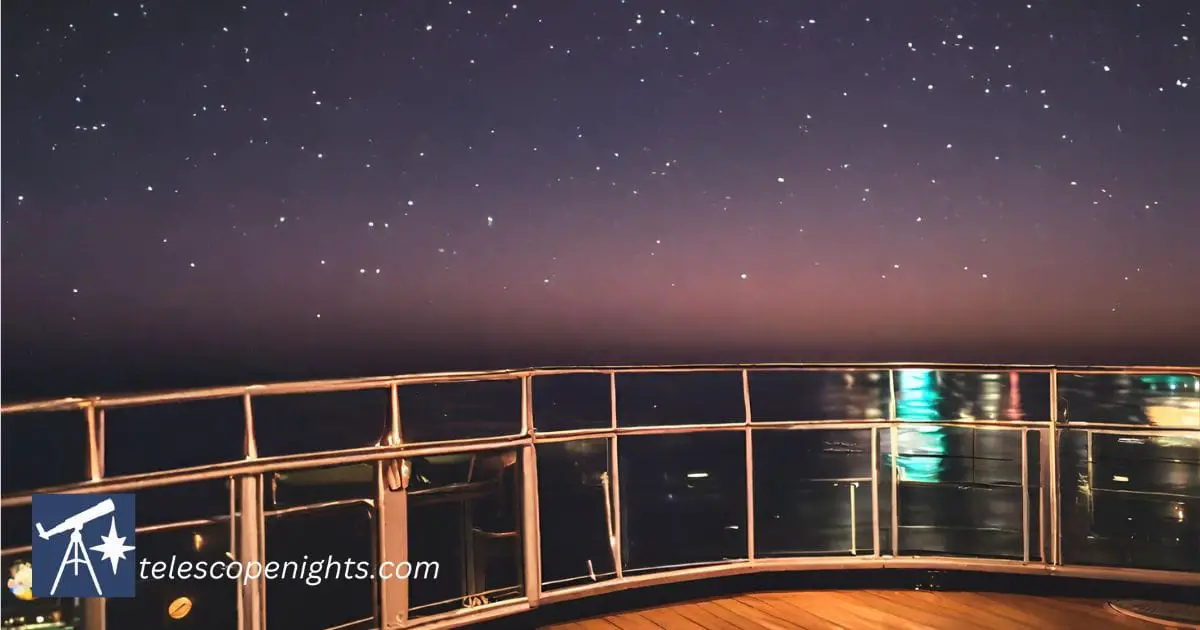You might be going on a cruise ship, where you’ll get the chance to gaze at the night sky, where city lights can’t interfere, and the sky stretches wide open above you. Here are some tips to help you make the most of that experience.

Ship’s Movement and Stability
Unlike stationary stargazing on land, the ship’s movement can make it hard to set your equipment on night sky objects. Even with the naked eye, the movement can interfere with targeting celestial sights.
Tip: Wait till the ship is navigating over smoother waters, e.g. when sailing in the open sea rather than near coastlines.
Also, try and find a spot on the deck where it’s more stable, such as near the center of the ship. This can reduce the movement effect.
Light Pollution on Board
Even at sea, light pollution can be a problem. It can come from the ship itself and hinder your view of the stars.
The bright lights of ships can scatter in the atmosphere and create a glow diminishing the contrast between the stars and the night sky, making it harder to see. This effect is particularly pronounced near busy ports and heavily trafficked maritime routes.
Tips:
- Find the best spots on the ship for clear sky views.
- Seek out darker areas of the ship for clearer skies.
- Look for areas not directly illuminated by deck lights.
- Wait till the ship is out in open seas.
Some cruise ships might offer designated stargazing areas after dark, so it’s worth checking this out.
Timing and Itinerary
The ship’s route and the time of year can significantly impact what constellations and celestial events you can observe.
Consider the phase of the moon during your cruise. A new moon is ideal for stargazing, as the sky is at its darkest.
Tip: Find out the ideal times for stargazing at sea – Research the ship’s itinerary and match it with celestial calendars to plan your stargazing nights.
For instance, if you’re cruising in the Southern Hemisphere, you might catch a glimpse of the Southern Cross, which isn’t visible from most Northern latitudes.
Equipment and Apps
Bringing along binoculars or a portable telescope can help your stargazing experience. However, balancing these on a moving ship can be challenging and consider whether you want that extra packing.
Tip: If you do bring one, make sure you have a sturdy tripod with adjustable legs to handle the ship’s movement more effectively
Otherwise you can use smartphone apps that map the night sky. These can help you identify stars, planets, and constellations more easily as well as timing, i.e. the celestial calendar for upcoming celestial events during your cruise.
Engage with Onboard “Trip Astronomers”
Some cruises might offer information sessions and night sky observations led by trip astronomers.
Tip: Take advantage of these sessions not only to learn but also to access areas of the ship that might be restricted to regular passengers or set up specifically for stargazing.
Engaging with these experienced night-sky viewers can also provide insights into celestial phenomena you might otherwise miss.
No matter where you find yourself looking up at the night sky, patience is key. Allow your eyes to adjust to the darkness (this can take up to 20 minutes), and you’ll gradually see more stars and constellations. Stargazing is not just about what you see; it’s about connecting with the cosmos and feeling a part of something much larger than ourselves.
